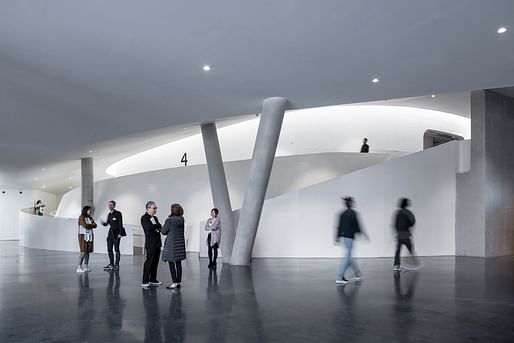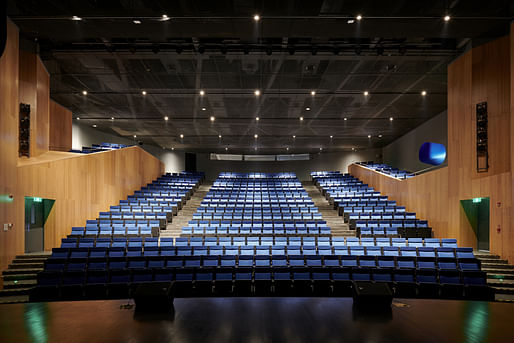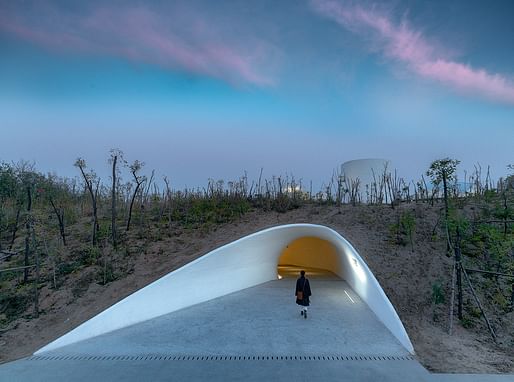
Following last week’s visit to California-based McClean Design, we are moving our Meet Your Next Employer series to Beijing this week, where we explore the work of OPEN Architecture.
Founded by Li Hu and Huang Wenjing, the firm established its Beijing office in 2008 after spending some formative years working on high-profile projects at Steven Holl Architects and Pei Cobb Freed & Partners. OPEN engages with architecture, urban design, landscape design, and interiors, as well as research. Earlier this year, we covered OPEN’s nomination for the Créateurs Design Award, while last year, we reported on the firm’s newly-designed campus center in Suzhou and their tent-like Yantai Sun Tower, both in China.
Over on Archinect Jobs, the firm is currently hiring an Architect to join its Beijing office. For candidates interested in applying for the position, or anybody interested in learning more about the studio’s work, we have rounded up five projects with unique geometric forms by OPEN Architecture that demonstrates their design approach.
Situated at the base of a valley famous for holding remnants of the Ming Dynasty Great Wall, the Chapel of Sound comprises a semi-outdoor concert hall whose form is heavily influenced by its natural surroundings. The hall’s rough exterior is made of concrete mixed with an aggregate of crushed local rock, which the firm describes as “timeless and alien—as if some strange and prehistoric boulder had fallen and come to rest at the bottom of the valley long ago.”
The form of the hall is shaped by the acoustics of its interior, which initially took inspiration from the human ear. Openings on the top and sides of the structure act as sound-absorbing areas to avoid reverberations during performances, while also allowing sound from the valley to filter through the interior when the hall is not hosting events.
OPEN Architecture developed HEX-SYS as a reaction to the vast amount of flamboyant but short-lived buildings that emerged during China’s construction boom in recent decades. The reconfigurable, reusable building system is designed to be rapidly adapted to several functions before being disassembled and reused. The basic building cell measures 400 square feet with an inverted umbrella structure standing on a single pipe column.
“Inspired by both the ancient Chinese wooden building system which can be taken apart and rebuilt elsewhere with little damage, and Le Corbusier's Swiss Pavilion which summarized his lifelong research on modular building systems, we designed this prototype comprised of hexagonal cells with architectural, structural and mechanical systems all synthesized within the same geometrical rules,” OPEN explains. “Sandblasted and anodized aluminum panels are used for exterior cladding for their durability and low maintenance. Bamboo, the rapidly renewable material, is used throughout the interior spaces wherever wood is needed.”

Situated on the banks of Shanghai’s Huangpu River, Tank Shanghai sees five abandoned aviation fuel tanks and ancillary facilities converted into a contemporary art center. The 116,000-square-foot campus is interconnected through a Z-shaped ‘super surface’, comprising a landscaped swath of trees and grasses weaving across the site.
“Today, these tanks and the surrounding site—forgotten relics of the city's former Longhua Airport—have been given new life and relevancy,” OPEN explains. “Over the course of six years, together with the newly created underground space that connects the tanks, and two separate gallery spaces dotted in the surrounding landscape, these iconic tanks were transformed from fuel containers into a vibrant new art and cultural center.

Part of the OPEN-designed Shanghai Qingpu Pinghe International School, the Pinghe Bibliotheater sees a library, theater, and black box “interlock together like a Chinese puzzle.” The building’s unique form, and free-flowing interior spaces, are intended to both cultivate the students’ interests in reading and performing, as well as encourage their imagination to “roam freely in the ocean of knowledge,” OPEN says.

The building’s exterior form includes sharp skylights, ship portholes with round windows, and strong blue cladding, all designed to catch the eye of the passersby. While the wider campus sees functions decentralized in a village structure, the architects merged the library and theater out of a belief that explorative reading and thinking were critical but overlooked aspects of education systems.

Located on a quiet beach in northern China, the UCCA Dune Art Museum is designed to lie beneath the dune, with its organically-shaped spaces enveloped by sand. The interconnected spaces are designed to resemble primeval caves whose walls “were once the canvas for some of humanity’s earliest works of art.”

Moving through a dark entrance, the museum opens up into connected vaults of daylight and open space. A spiral staircase leads to a lookout over the sand dunes, encouraging visitors to find inspiration within both the museum and its natural surroundings.
Meet Your Next Employer is one of a number of ongoing weekly series showcasing the opportunities available on our industry-leading job board. Our Job Highlights series looks at intriguing and topical employment opportunities currently available on Archinect Jobs, while our weekly roundups curate job opportunities by location, career level, and job description.
No Comments
Block this user
Are you sure you want to block this user and hide all related comments throughout the site?
Archinect
This is your first comment on Archinect. Your comment will be visible once approved.